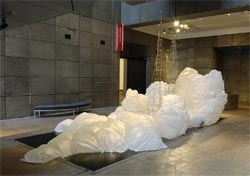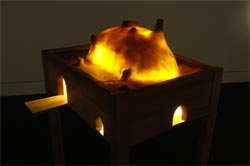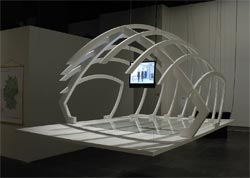Beyond Nowhere
2006 plastic bags, skewers, fans and electrical components © Joanna Langford
Storywater (detail)
2006 fibreglass, beech wood, beech bark, fungi, beeswax and mixed media
© Cat Simpson
Terminal Measures
2006 polystyrene, glass, aluminium and DVD
© Ri Williamson
Samuel Butler’s 1872 satire, Erewhon, depends upon two anagrams – the transliteration of ‘nowhere’ into ‘erewhon’ and the transformation of Victorian England into a strange, perplexing land beyond the mountains. Just as anagrams rearrange the familiar into unexpected and unpredictable forms, the works in Out of Erewhon: New Directions in Canterbury Art reshape the everyday, and in so doing invite us to experience the known world with new eyes. While the narrator of Butler’s famous novel would not confirm even the hemisphere in which his mysterious colony was located, the land of Erewhon is wholly defined by its antonymous relationship with England – as a ‘nowhere’ it is most definitely not an ‘anywhere’. Similarly, the artists in this exhibition construct, in very different ways, alternative, idiosyncratic versions of reality that are as specific, and as potentially revealing, as Jonathan Swift’s Lilliput or the world beyond Lewis Carroll’s looking glass.
This sense of a fictional, but closely corresponding universe is neatly captured in Rob Hood’s video work My Puddle, in which the Canterbury high country is literally reflected as a heroic, ‘big sky’ world, complete with mournful western soundtrack. Hood’s shimmering water is a kind of threshold between myth and reality, but also a trapdoor that leads us towards an alternative view of New Zealand’s pioneering days. The past, as they say, is a foreign country, and in the wake of Peter Jackson’s Lord of the Rings film trilogy, it is interesting to note that J.R.R. Tolkien maintained that his Middle Earth was not a place, but rather a time, a remote, fictional version of our own world’s history. Grant Wylie’s weathered concrete waka certainly seems to have washed up from another age. Its porous blocks form an anachronistic monument, and serve as a reminder that our notions of the present are built upon interpretations of the past that may, or may not, hold water.
Scott Flanagan’s ironically abstract paintings bring us squarely back into the present, making us newly aware of the act of looking and how that experience is mediated by the formal white cube of the gallery space. The territory opened up by his enquiries is, however, perhaps the least knowable of all, for his focus is the mind’s eye, within which we translate what we see into what we perceive. Equally conscious of the physical and art historical contexts within which it operates, Miranda Parkes’s Slumper actively subverts the traditions of abstraction and the decorative. Toying with our expectations of how abstract paintings should behave, she makes fresh and disruptive incursions into the yawning realm of possibility offered by a voluptuously unfurling canvas. With Reasons to be cheerful: small things, Richard van der Aa’s paintings are placed more incidentally to encourage accidental discovery; a series of modest and magical perforations in the hide of normality. They offer the comprehending viewer yet another way of navigating the gallery spaces – signposting a private tour through the architecture, collection and the artist’s own memories of his formative art encounters.
For several of the artists in Out of Erewhon, it is the act of entering another reality, rather than the reality itself, that provides fertile ground for exploration. In Ri Williamson’s Terminal Measures, the navigation of invasive airport security becomes a metaphor for the threat to personal freedom posed by fear and paranoia. In Williamson’s transformative control zone, we must modify our behaviour and surrender aspects of our personal identity if we wish to proceed, obedient and unchecked, to the departure gate. The rules of entry are even more demanding in Joanne Moar’s becoming german. By collecting memories of German childhoods, she emphasises the barriers an ‘outsider’ faces in accessing a new culture, while also questioning whether a typical German (or New Zealand) childhood could ever exist.
In terms of our identity, contemporary life offers us a new form of schizophrenia: the time we spend in the physical world is paralleled by our existence in the virtual matrix of electronic space. The difference between the two becomes apparent in Rob Hood’s Sentinel Post. The architectural structure we would readily accept as a viable fortress in the world of computer gaming appears disconcertingly stagy and provisional in the warm light of day. Peter Trevelyan’s Patron presents us with a myriad of disrupted reflections in a kaleidoscopic mirrored cauldron, breathing new life into the other ‘selves’ we leave behind us within in the ever-vigilant memories of rapidly multiplying public surveillance networks.
Not all of the worlds in Out of Erewhon are futuristic or unfamiliar. Several artists explore the possibilities of that most fantastic and ordinary machine, the human body. In Phil Murray’s nascent plaster spheres, internal cavities appear as rents and fissures, fractured glimpses of a world that is both recognisable and endlessly strange. In contrast, it is the absence of the body that activates Clare Noonan’s work, whether it is the impression left by her body in a patch of soft grass, or the abrupt disjunction of her sectioned arm and hand. Delicately modified to incorporate a tiny compass, the latter presents the body as a self-referencing navigational device.
For Joanna Langford, references to childhood open up a portal into a private universe of the imagination. The vertiginous exaggerations of scale and commonplace materials she chooses evoke the inviting realm of make-believe, but they also represent the crumpling collapse of time, forcing us to acknowledge that each passing moment makes those remembered countries ever more inaccessible. The rotating shadow-play of Hannah and Aaron Beehre’s DeArmond invites us to enter another world completely – a zone of frustration and yet possibility, where familiar shapes lose their established symbolic meanings and we see them anew. The upturned baths and eldritch inhabitants of Cat Simpson’s Storywater offer us one final journey down the rabbit-hole, to a fantastic, nonsensical place where familiar organic materials combine with a strange narrative to conjure up an atmosphere of magical potential.
Whether they appear as internal or external, constructed, remembered or imaginary, one rule becomes clear when considering the alternative realities posed by Out of Erewhon. Due care should be taken not to confuse ‘nowhere’ with ‘nothingness’, for there is much to be learned and appreciated about our own world from our travels in these invented countries. After all, as Tolkien’s Gandalf would have it, ‘not all those who wander are lost’.
Text by Felicity Milburn


